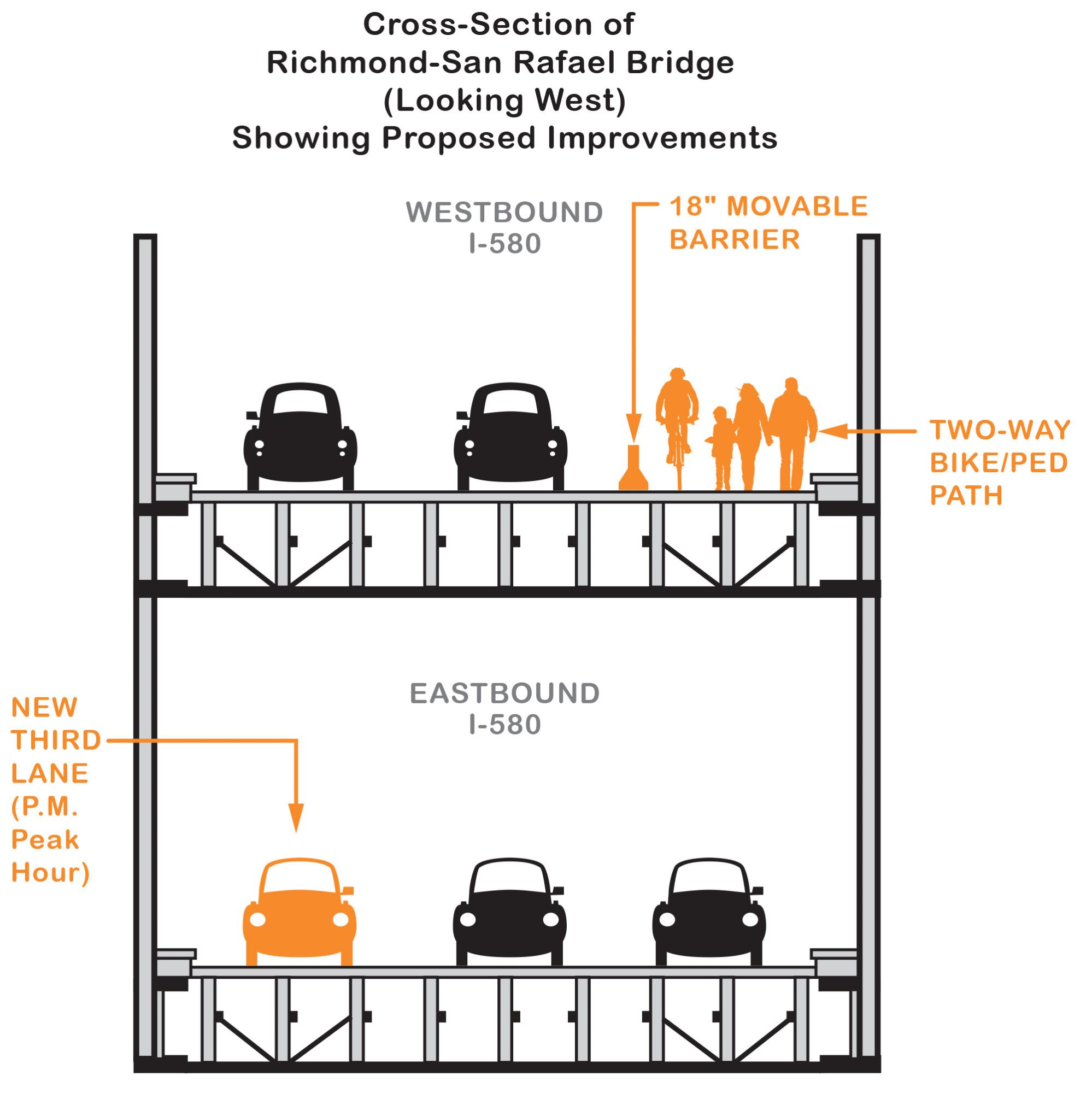Marin IJ Editors Join Push to Abort Bridge Bike and Pedestrian Path
5:20 PM PST on February 5, 2018

mage: MTC
Note: GJEL Accident Attorneys regularly sponsors coverage on Streetsblog San Francisco and Streetsblog California. Unless noted in the story, GJEL Accident Attorneys is not consulted for the content or editorial direction of the sponsored content.
Momentum is growing to eliminate the planned bike and ped path on the upper deck of the Richmond-San Rafael Bridge. Last week, Marin Independent Journal columnist Dick Spotswood, a consistent opponent of bicycle infrastructure, asked readers to contact their supervisors to urge the Metropolitan Transportation Commission (MTC) to study a "compromise" that would continue to leave cyclists with no way to cross the bridge, in either direction, during peak periods. "Callers might ask their county supervisors if they biked to work that day--or ever," quipped Spotswood.
Spotswood, along with the editorial board of his newspaper, is piling on to a push that started when Marin County Supervisor Damon Connolly (who clearly does bike to work at least some of the time) and Orinda Mayor Amy Worth, who both sit on the Metropolitan Transportation Commission and the Bay Area Toll Authority, asked staff to study the idea of converting the planned bike lane into another car lane.
This would supposedly be done via a movable barrier, so bikers and walkers could still use it at off-peak times. Of course, as Spotswood indicated in a follow-up piece over the weekend, Connolly and other supporters of taking away the bike lane during rush hour don't just want a study; they want to kill the bike lane.
Ironically, going by past columns, Spotswood seems to believe in the concept of "induced demand."
That is the well-documented concept that creating more car lanes, in the long term, makes traffic worse. As described in a previous Streetsblog post, research from the National Center for Sustainable Transportation shows that “numerous studies have examined the effectiveness of this approach and consistently show that adding capacity to roadways fails to alleviate congestion for long because it actually increases vehicle miles traveled.”
As Streetsblog's Brian Addison wrote in that piece, if anyone wants more nonprofit, nonpartisan, academically-sound research, here’s one. Here’s another. And another. And another. And another. And another. And another. And another. And another. And another. And another.
At this point denying induced demand is akin to denying that human activity causes global climate change (and, not surprisingly, the same oil-funded 'think tanks' that deny climate change also deny induced demand).
And Spotswood, in a column written less than a year ago entitled "Adding lanes is not going to solve Marin’s traffic jam," seems to agree with induced demand. He describes the results of a study on the subject as showing that "spending billions more to 'solve' traffic congestion" is a "fool’s errand."
He also writes that "Peak-period Richmond-San Rafael Bridge crossings are a daily purgatory" and "adding lanes is not going to solve Marin’s traffic jam [emphasis added]."
Nevertheless, he advocates for another lane on the bridge--and he wants cyclists who want to cross the bridge during rush hour to be forced to load their bike onto a bus or a taxi and join that purgatory.
Meanwhile, in countries where people do ride bikes in huge numbers, they don't just look at an individual bridge or road and ask how many people want to bike here. Instead, they provide a system of safe and smooth cycling paths and highways almost everywhere so that riders can be confident they can always get where they need to go, safely, by bike. That's what it takes for bikes to become an integral part of the transportation picture. But if the region effectively bans bikes everywhere there isn't currently sufficient demand, how's anybody ever supposed to use a bike for transportation?
A study of the San Rafael bridge probably will show that it isn't and might never be, on its own, one of the most popular cycling route in the Bay Area--given the crappy approaches to the bridge, that wouldn't even come as a surprise. But it should be self-evident that we're never going to make cycling a hugely significant part of mode share if we don't even allow cyclists to get where they need to go.
"A wealth of evidence highlights how safe and convenient bicycle routes translate into less congested roads, especially during commute hours. And of course each bicycle trip equals one less car on the road," wrote Jim Elias of the Marin County Bicycle Coalition (MCBC) in a guest piece for Streetsblog. "MCBC understands why there's a call to evaluate whether opening the Richmond-San Rafael Bridge's pathway to cars during commute hours would relieve congestion for westbound traffic. To date, we've yet to see data supporting that position," he added in an email to Streetsblog about the Marin IJ editorials.
For some 40 years, cycling advocates have asked for one shoulder (that could double as a maintenance and emergency lane) on a bridge with four--soon to be five--lanes for cars. That means cyclists and pedestrians get less than one-sixth of the road surface on the bridge, with all the rest going to cars. But Spotswood, as well as the editorial board of the Marin IJ, define fairness and compromise as "studying" whether to give every last inch of the bridge to motorists during peak periods.
If that's not your definition of fairness, you might want to contact the MTC commissioners to voice your support for the bike path on the bridge.
Stay in touch
Sign up for our free newsletter
More from Streetsblog San Francisco
Weekend Roundup: Bancroft Lane Gets Concrete, Party in Downtown S.F.
...and the Bay Bridge to get its lights back
Richmond-San Rafael Bridge Bike Lane Will Need Support
There's no evidence the bike lane contributes to congestion on the bridge
Update on Oakland DOT’s Lakeshore Protected Bike Lane Project
Public seems fairly positive and accepting towards the coming project. Let's hope it stays that way




